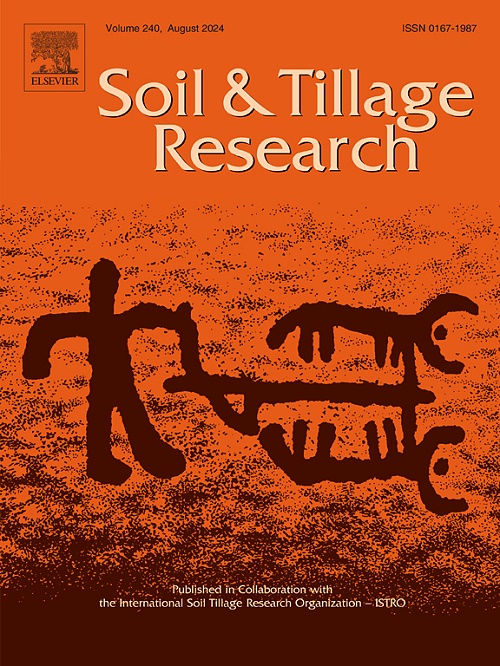Does 46 years of conservation tillage and crop rotations change soil carbon and nitrogen distribution and storage?
IF 6.1
1区 农林科学
Q1 SOIL SCIENCE
引用次数: 0
Abstract
Soil conservation practices, including no-tillage and crop rotation, are widely promoted to enhance soil quality and sequester carbon (C), thereby contributing to climate change mitigation. This study investigates the long-term impacts of tillage intensity and crop rotation on soil organic carbon (SOC) and total nitrogen (TN) distribution and storage to a depth of 1 m in a U.S. Midwest Mollisol. Tillage treatments included no-tillage (NT), intermediate or reduced tillage (chisel plow: CP), and intensive tillage (moldboard plow: MBP), with three crop rotations: continuous corn (CC), corn-soybean (CB), and continuous soybean (BB). After 46 years of continuous management, NT systems stored, on average, 15 Mg ha⁻¹ more SOC and 2.0 Mg ha⁻¹ more TN than tilled systems when the full depth profile was considered. The SOC and TN storage were similar between the CP and MBP treatments, suggesting limited benefit of CP over MBP in long-term C and N retention. Crop rotation had minimal effects on SOC storage; however, CC systems accumulated significantly more TN than CS and BB rotations, particularly when assessed on an equivalent soil mass basis. Additionally, tillage practices had a pronounced effect on the vertical distribution of SOC and TN, especially within the upper 75 cm of the soil profile. These findings highlight the importance of deep soil sampling for accurately capturing the full impact of management practices and suggest that long-term NT is more effective at promoting SOC and TN storage than conventional tillage, regardless of intensity.
46年的保护性耕作和作物轮作是否改变了土壤碳氮的分布和储存?
土壤保持做法,包括免耕和作物轮作,正在广泛推广,以提高土壤质量和固碳(C),从而有助于减缓气候变化。研究了耕作强度和轮作对美国中西部Mollisol 1 m深度土壤有机碳(SOC)和全氮(TN)分布和储存的长期影响。耕作处理包括免耕(NT)、中间或减少耕作(凿子犁:CP)和精耕细作(犁板犁:MBP), 3种作物轮作:玉米连作(CC)、玉米-大豆连作(CB)和大豆连作(BB)。经过46年的持续管理,当考虑到全深度分布时,NT系统比耕作系统平均多储存15 Mg ha⁻¹ 的SOC和2.0 Mg ha⁻¹ 的TN。CP和MBP处理的土壤有机碳和总氮储量相似,表明CP在长期碳氮保持方面的优势有限。轮作对有机碳储量影响最小;然而,连作系统累积的全氮明显多于轮作和轮作,特别是在等效土壤质量基础上进行评估时。此外,耕作方式对土壤有机碳和全氮的垂直分布有显著影响,特别是在75 cm的土壤剖面内。这些发现强调了深层土壤采样对于准确捕获管理实践的全面影响的重要性,并表明长期NT在促进有机碳和全氮储存方面比传统耕作更有效,无论强度如何。
本文章由计算机程序翻译,如有差异,请以英文原文为准。
求助全文
约1分钟内获得全文
求助全文
来源期刊

Soil & Tillage Research
农林科学-土壤科学
CiteScore
13.00
自引率
6.20%
发文量
266
审稿时长
5 months
期刊介绍:
Soil & Tillage Research examines the physical, chemical and biological changes in the soil caused by tillage and field traffic. Manuscripts will be considered on aspects of soil science, physics, technology, mechanization and applied engineering for a sustainable balance among productivity, environmental quality and profitability. The following are examples of suitable topics within the scope of the journal of Soil and Tillage Research:
The agricultural and biosystems engineering associated with tillage (including no-tillage, reduced-tillage and direct drilling), irrigation and drainage, crops and crop rotations, fertilization, rehabilitation of mine spoils and processes used to modify soils. Soil change effects on establishment and yield of crops, growth of plants and roots, structure and erosion of soil, cycling of carbon and nutrients, greenhouse gas emissions, leaching, runoff and other processes that affect environmental quality. Characterization or modeling of tillage and field traffic responses, soil, climate, or topographic effects, soil deformation processes, tillage tools, traction devices, energy requirements, economics, surface and subsurface water quality effects, tillage effects on weed, pest and disease control, and their interactions.
 求助内容:
求助内容: 应助结果提醒方式:
应助结果提醒方式:


